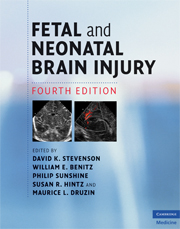Book contents
- Frontmatter
- Contents
- List of contributors
- Foreword
- Preface
- Section 1 Epidemiology, pathophysiology, and pathogenesis of fetal and neonatal brain injury
- Section 2 Pregnancy, labor, and delivery complications causing brain injury
- Section 3 Diagnosis of the infant with brain injury
- Section 4 Specific conditions associated with fetal and neonatal brain injury
- 22 Congenital malformations of the brain
- 23 Neurogenetic disorders of the brain
- 24 Hemorrhagic lesions of the central nervous system
- 25 Neonatal stroke
- 26 Hypoglycemia in the neonate
- 27 Hyperbilirubinemia and kernicterus
- 28 Polycythemia and fetal–maternal bleeding
- 29 Hydrops fetalis
- 30 Bacterial sepsis in the neonate
- 31 Neonatal bacterial meningitis
- 32 Neurological sequelae of congenital perinatal infection
- 33 Perinatal human immunodeficiency virus infection
- 34 Inborn errors of metabolism with features of hypoxic–ischemic encephalopathy
- 35 Acidosis and alkalosis
- 36 Meconium staining and the meconium aspiration syndrome
- 37 Persistent pulmonary hypertension of the newborn
- 38 Pediatric cardiac surgery: relevance to fetal and neonatal brain injury
- Section 5 Management of the depressed or neurologically dysfunctional neonate
- Section 6 Assessing outcome of the brain-injured infant
- Index
- Plate section
- References
28 - Polycythemia and fetal–maternal bleeding
from Section 4 - Specific conditions associated with fetal and neonatal brain injury
Published online by Cambridge University Press: 12 January 2010
- Frontmatter
- Contents
- List of contributors
- Foreword
- Preface
- Section 1 Epidemiology, pathophysiology, and pathogenesis of fetal and neonatal brain injury
- Section 2 Pregnancy, labor, and delivery complications causing brain injury
- Section 3 Diagnosis of the infant with brain injury
- Section 4 Specific conditions associated with fetal and neonatal brain injury
- 22 Congenital malformations of the brain
- 23 Neurogenetic disorders of the brain
- 24 Hemorrhagic lesions of the central nervous system
- 25 Neonatal stroke
- 26 Hypoglycemia in the neonate
- 27 Hyperbilirubinemia and kernicterus
- 28 Polycythemia and fetal–maternal bleeding
- 29 Hydrops fetalis
- 30 Bacterial sepsis in the neonate
- 31 Neonatal bacterial meningitis
- 32 Neurological sequelae of congenital perinatal infection
- 33 Perinatal human immunodeficiency virus infection
- 34 Inborn errors of metabolism with features of hypoxic–ischemic encephalopathy
- 35 Acidosis and alkalosis
- 36 Meconium staining and the meconium aspiration syndrome
- 37 Persistent pulmonary hypertension of the newborn
- 38 Pediatric cardiac surgery: relevance to fetal and neonatal brain injury
- Section 5 Management of the depressed or neurologically dysfunctional neonate
- Section 6 Assessing outcome of the brain-injured infant
- Index
- Plate section
- References
Summary
Introduction
Since the third edition, this chapter has been expanded to cover both polycythemia and fetomaternal hemorrhage, a topic that is not extensively or comprehensively discussed in most commonly used textbooks. In the former the hematocrit and blood volume are generally increased, while in the latter both are generally very low. In both conditions, however, there is concern about inadequate organ blood flow, oxygenation delivery, and potential for hypoxic injury, especially in the brain. A large body of definitive information on polycythemia is available that allows conclusions to be made as to management and patient outcome. However, the area of fetomaternal hemorrhage has not been as comprehensively investigated and relies mostly on small clinical series and case reports. There are no controlled basic or clinical trials, which hampers our understanding of pathophysiology as well as therapeutic modalities. This leaves us with gaps in our knowledge of this important topic. What is presented here is the most current body of information and recommendations for diagnosis, treatment, and reported outcomes.
Polycythemia
Polycythemia and hyperviscosity were first associated with adverse neurologic events and sequelae in a series of case reports. The first case often referenced was published by Wood in 1952, and this was followed by a small series of infants with polycythemia and hyperviscosity who displayed multiple problems, including cerebral dysfunction.
- Type
- Chapter
- Information
- Fetal and Neonatal Brain Injury , pp. 317 - 324Publisher: Cambridge University PressPrint publication year: 2009

